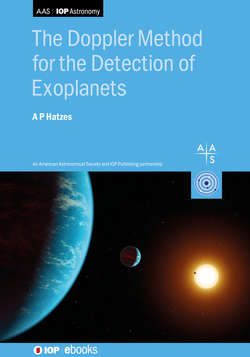Читать книгу The Doppler Method for the Detection of Exoplanets - Professor Artie Hatzes - Страница 10
На сайте Литреса книга снята с продажи.
The Doppler Method for the Detection of Exoplanets A P Hatzes Chapter 1 Introduction 1.1 The Dawn of Doppler Measurements
ОглавлениеIn 1842, the Austrian physicist, Christian Doppler, published his treatise Über das farbige Licht der Doppelsterne und einiger andere Gesterne des Himmels (On the Colored Light of Binary stars and Some Other Stars in the Heavens). Doppler postulated that because the pitch of a sound wave depended on the relative speed between the source and the observer that the color of light of a moving star should also change. Doppler thought that this phenomenon could explain the colors of binary stars. Although wrong about the colors of stars, his hypothesis about the change in the frequency of waves relative to a moving source—and that the effect can be used to measure the velocity of stars—proved true. It was shown to be experimentally correct for sound waves and had an easy theoretical explanation, but not so for electromagnetic waves.
At the same time, Armand Hippolyte Louis Fizeau also became involved with aspects of the discovery of the Doppler effect (known as the Doppler–Fizeau effect in France). He focused his work on understanding the effect as applied to light rather than sound and developed the mathematical formalism underlying the principle. He was the first to predict the redshift of electromagnetic waves.
Remarkably, there was early debate among physicists as to whether Doppler’s principle could even be applied to light waves (Vogel 1900). An early and elegant demonstration of the Doppler effect applied in astronomy was made by James E. Keeler in his seminal paper “A Spectroscopic Proof of the Meteoritic Constitution of Saturn’s Ring” (Keeler 1895, p. 416). It is obvious now, but at that time it was not known whether the rings were solid or consisted of small particles in orbit around Saturn. He also could foresee the power of the Doppler method: “I have recently obtained a spectroscopic proof of the meteoritic constitution of the ring, which is of interest because it is the first direct proof of the correctness of the accepted hypothesis, and because it illustrates in a very beautiful manner (as I think) the fruitfulness of Doppler’s principle, and the value of the spectroscope as an instrument for the measurement of celestial motion.”
His results, published in the first issue of The Astrophysical Journal (Figure 1.1), clearly show the solid body motion of the planet and the Keplerian motion of the ring. Coincidentally, Keeler was eager to apply Doppler measurements for spectroscopic measurement of the velocity of galaxies (Osterbrock 2002). Unfortunately, he died tragically in 1900 at the young age of 42, and the discovery of the expanding universe had to await the work of Edwin Hubble.
Figure 1.1. A reproduction of the figure from Keeler (1895) showing the Doppler velocity along Saturn using long-slit spectroscopy of Saturn. The spectrum crossing the planet’s disk shows the Doppler motion of solid body rotation. The spectrum from the rings show Doppler motion consistent with Keplerian motion.
Doppler’s principle could indeed be applied to light with fruitful results, and it has produced some of the most fundamental discoveries in astronomy. Some examples include
Hubble’s relationship between the distance of a galaxy and its redshift (velocity). This established the fact that the universe was expanding as one of the fundamental principles of cosmology (Hubble 1929).
The flat rotation curves of galaxies, which was one of the first evidence of dark matter (Rubin et al. 1978).
The rotation of stars and the rotation break at spectral type mid-F stars. This was early evidence that magnetic activity is responsible for stellar angular momentum loss while a star is on the main sequence (Kraft 1967).
The discovery of exoplanets (Mayor & Queloz 1995).
This book is devoted to the last item—the use of stellar radial velocity (RV) measurements for the detection and study of exoplanets. Over the past two decades, the field of exoplanets has developed into one of the most vibrant fields of astrophysics. As of this writing, thousands of planets have been discovered orbiting other stars. This exciting field owes its existence to Doppler’s method, through which the first exoplanets were discovered.
